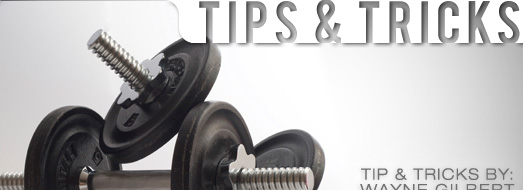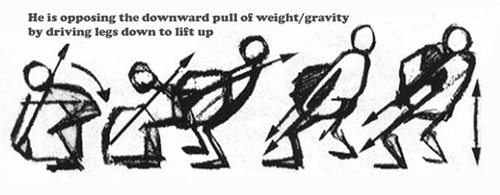
|
|
 |
|
|
|
Did you know that while Horton Hears Who may be the first computer animated Dr Seuss story, it is the second Dr. Seuss movie to star Jim Carrey (How the Grinch stole Christmas), the second computer animated movie to star Steve Carell (Over the Hedge), and the second movie to star both Jim Carrey and Steve Carell (Bruce Almighty)! |
|
|
|
|
|
|
|
 |
|
|
|
 |
|
|
|
Hi everyone! As I mentioned last month, we're having our first ever Tips & Tricks guest writer this time out, Wayne Gilbert. Many of you know Wayne from Sheridan College or Disney or ILM or EA or his website: www.anamie.com. You might even know Wayne from the classes he's taught at Animation Mentor. For me, I know Wayne because he taught me pretty much everything I know about animation. As my mentor, he was incredibly generous with his time and knowledge, and he taught me just as much about life as he did about animation. When it comes to animation teachers, you won't find many better than Wayne Gilbert, that's for sure, and we're honored to have him writing this month's Tips & Tricks article! Next month, we'll return to our regularly scheduled "Ask Shawn" format. I've received some great questions in the last few weeks, and we'll be addressing them next month! In the meantime, please keep those "Lightning Round" questions (or any other feedback) flowing to: tipsandtricks@animationmentor.com I'll see you guys next month - in the meantime, enjoy Wayne's thoughts on showing weight! shawn :) Weight in Animation By: Wayne Glbert By: Wayne GlbertWeight is described through the visual presentation of opposing forces. That’s it. Stop here or continue reading for accompanying babble and random thoughts.
Force does not exist in animation. It is implied through posture, path of action, balance, timing, arcs, successive breaking of joints and on and on. It is implied by what the character does. Deciding why a character moves will reveal how it moves. Hold on, this is about weight, not force. No, wait, weight cannot be shown without the visual implication of FORCE. Wait, force and weight don’t exist in animation, there can only be a visual implication. There are two types of FORCE – internal and external. The Principles of Animation as listed in The Illusion of Life: Squash and stretch Nine of the Principles of Animation are a result of, or create a FORCE. Let’s take a stab at re-thinking, re-defining and prioritizing the Principles of Animation and call them, say, The Principles of Movement. FORCE - priority one Physical Aesthetic - creates an emotional/psychological response/force in the audience Skill and Methodology: Weight is all in the timing. Well posture and timing. But then context plays a role in why the character moves which dictates how. Ah man, now I’m rambling and sound like Shawn Kelly. Do over. It’s all in the timing. True, but what are we timing? We’re timing thought and effort/force. How much effort must the character exert to successfully accomplish the task it decided to accomplish? For an animator, weight is a visual presentation of opposing forces. When a character jumps up, it is actually driving down against the ground. The faster it can drive down the higher it will jump. The character can enhance the power of the jump by properly timing the thrusting of shoulders and arms in the direction of the jump. Study a high jumper or long jumper. Once the force needed to jump is believably represented visually, the principles of movement are initiated. If the character is weak and heavy it takes more effort to jump, pull or push, which influences timing which influences the principles. Why does the ground shake when the ‘500 pound’ Incredible Hulk walks? He’s strong enough to jump half a mile, he should be able to tip toe quietly. Ok I’m rambling again. When I read this article tomorrow I’ll probably want to re-word it as I have everyday since starting it and now I sound like Shawn again. ‘Random thought’- in an animated walk, make sure that the ‘impact’ is visually defined. That could be one goal for showing weight. Watch slow motion live action walking and pay close attention to the impact frames. Going into the impact/compression shows how much effort is exerted to stop the body weight from its downward motion and coming out of the impact/compression describes how much effort is needed to raise the body ‘weight’. Keep in mind, the slower the cadence the more weight shift from side to side there needs to be. The further apart the feet are the more you have to shift weight side to side. As these following examples are copyright protected I can only direct you to the source. In American History X, just before Edward Norton is arrested there is a sequence of him walking toward the camera. The shot is from the waist up but you can tell what the hips, legs and feet are doing. This is proof positive that you have to animate what is not seen as well as what is in frame if you want it to be correct. Balance is extremely important to support the visual implication of weight. Weight must be over or nearly over one foot before the other can be raised while maintaining balance. Stand with your feet shoulder width apart, raise one foot 18” off the ground and hold it there for five seconds - but don’t shift your hips (or hold on to something or fall). Weight must shift from side to side in leading the balance during a walk. These examples from The Iron Giant do not address the fact that we may be looking at a directorial decision for mechanical stylization. (See if a lawyer can get through that one). The Iron Giant – to shift weight or not? At the electrical station and in the final battle scene the giant lacks ‘human characteristics’ and there is no weight shifting in his walk, but at the pond there is. 1 – First time Hogarth sees the Iron who walks over him at the power plant. The timing of a character lifting a heavy object has to be properly blended with the correct posture and balance to describe appropriate effort. 300 lbs can look light if the character is strong Here is an example of an animated character that looked at the story reel, planned what he wanted to lift, did sketches and then shot video reference before proceeding. This is an example of an animated character that didn’t bother planning beyond the story reel. He got a bit cocky and didn’t evaluate the repercussions of beginning the action before he knew what he was doing. Weight is described through the visual presentation of opposing forces. If you have questions – email Shawn Kelly at tipsandtricks@animationmentor.com. |
|
|
|
|
|
|
|
 |
|
||
|
|
|
|
||
|
|
|
|
